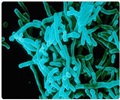The shocking revelation that almost three-quarters of the world’s diphtheria cases reside in Andhra Pradesh state of India has served as a shot in the arm for concerned officials. There are now desperate moves to immunize as many as 2,500 students of government schools in the city.
The Directorate of Health in association with National Institute of Epidemiology (NIE), Chennai, launched the drive. A pilot study in the twin cities will concentrate on the Old City. This is because 16 per cent (891 cases) of India's 5,826 diphtheria cases (4,161 cases in Andhra Pradesh alone) were reported from here.According to most recent figures, 71 per cent of the world's diphtheria cases are from Andhra Pradesh. Hyderabad’s head count had risen to 891 cases in 2006. As the Directorate of Health has vaccine only for children below seven years, a special vaccine for those above seven has been bought from the Serum Institute by the NIE. These were administered to children at Alia and Mahbubia Government School on the first day.
Carried out in seven government schools and junior colleges, the study collected samples from 2,500 children in November 2006. These were then processed at Moulana Azad Medical College, Delhi and the results came out in October this year. The study gave that 59 per cent of these 2,500 children were susceptible to the disease.
"Unexpectedly, we also found that 13 per cent of the children were also susceptible to Tetanus. Till now, there was a common perception that all children were immunized against tetanus and this finding came as a surprise," Dr B Sailaja, who carried out the study said. "An air-borne disease, toxins released through the white membrane that is formed in the throat goes into the blood and affects the heart. People are getting their children immunized at the primary-level but a booster dose, which is to be administered at the age of one and a half years and five years, is being ignored due to unawareness. Thereby, immunity levels are going down in children," she added.
Doctors of Fever Hospital say that 3.5 per cent to 4 per cent of cases reported from Medak, Ranga Reddy and Mahbubnagar districts end in deaths, while it is just 1 to 2 per cent in Hyderabad. The Directorate of Health will be extending the vaccination drive to all schools in the city.
Diphtheria is an acute infectious disease caused by the bacteria Corynebacterium diphtheriae. It is spread through respiratory droplets produced by a cough or sneeze of an infected person or someone who carries the bacteria but displays symptoms. It can also be spread by contaminated objects or foods (such as contaminated milk). Symptoms usually occur 2 to 5 days after contact with the bacteria. The bacteria usually infect the nose and throat. The throat infection causes a gray-to-black, tough, fiber-like covering, which can block the airways. In some cases, diphtheria may first infect the skin, producing lesions on the skin.
Advertisement
Because of widespread and routine childhood DPT vaccinations, diphtheria it is now rare in many parts of the world. Among risk factors are a crowded environment, poor hygiene, and lack of immunization.
Advertisement
Source-Medindia
ANN/M






